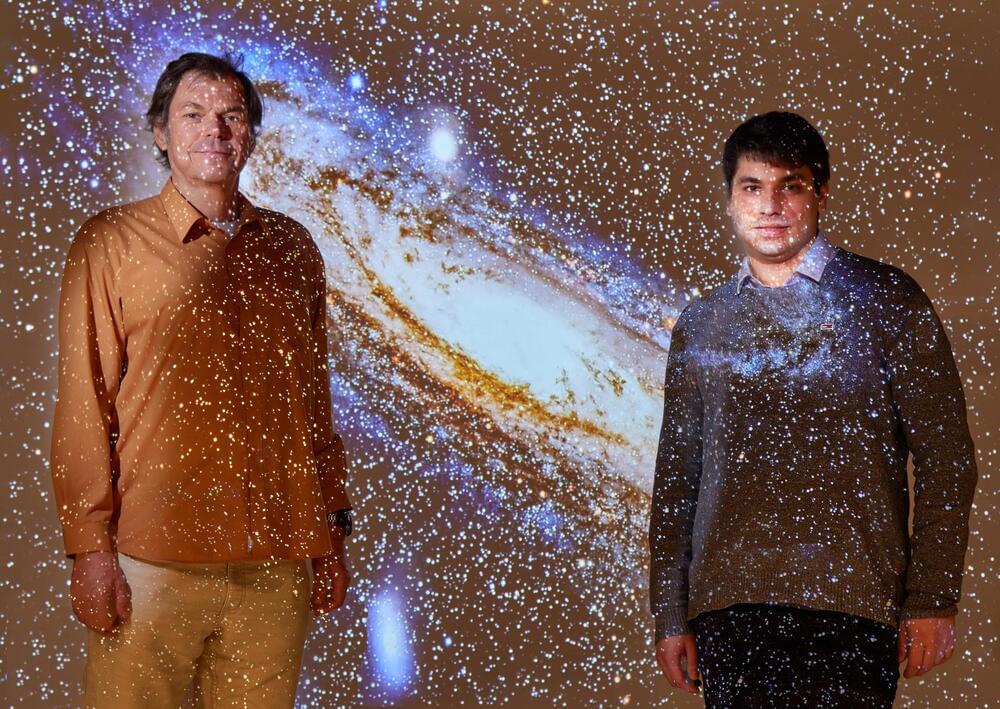Category: evolution – Page 120
New technique to map dark web vendors’ personalities and identities in different illegal marketplaces
A new research methodology has allowed specialists to track active vendors in several dark web platformsbased solely on how they write their ads and posts. Using stylometry, the experts were able to analyze thousands of identities of various suppliers in black markets and identify if these profiles correspond to specific people.
This study involved the collection of nodes of information extracted from vendor profiles on four now-shutdown cybercriminal platforms, including Valhalla, Dream Market, Evolution, and Silk Road 2.


Observing more disk galaxies than theory allows
The Standard Model of Cosmology describes how the universe came into being according to the view of most physicists. Researchers at the University of Bonn have now studied the evolution of galaxies within this model, finding considerable discrepancies with actual observations. The University of St. Andrews in Scotland and Charles University in the Czech Republic were also involved in the study. The results have now been published in the Astrophysical Journal.
Most galaxies visible from Earth resemble a flat disk with a thickened center. They are therefore similar to the sports equipment of a discus thrower. According to the Standard Model of Cosmology, however, such disks should form rather rarely. This is because in the model, every galaxy is surrounded by a halo of dark matter. This halo is invisible, but exerts a strong gravitational pull on nearby galaxies due to its mass. “That’s why we keep seeing galaxies merging with each other in the model universe,” explains Prof. Dr. Pavel Kroupa of the Helmholtz Institute for Radiation and Nuclear Physics at the University of Bonn.
This crash has two effects, the physicist explains: “First, the galaxies penetrate in the process, destroying the disk shape. Second, it reduces the angular momentum of the new galaxy created by the merger.” Put simply, this greatly decreases its rotational speed. The rotating motion normally ensures that the centrifugal forces acting during this process cause a new disk to form. However, if the angular momentum is too small, a new disk will not form at all.

Supermountains controlled the evolution of life on Earth
Giant mountain ranges at least as high as the Himalayas and stretching up to 8,000 kilometers across entire supercontinents played a crucial role in the evolution of early life on Earth, according to a new study by researchers at The Australian National University (ANU).
The researchers tracked the formation of these supermountains throughout Earth’s history using traces of zircon with low lutetium content—a combination of mineral and rare earth element only found in the roots of high mountains where they form under intense pressure.
The study found the most giant of these supermountains only formed twice in Earth’s history—the first between 2,000 and 1,800 million years ago and the second between 650 and 500 million years ago. Both mountain ranges rose during periods of supercontinent formation.
Dr. Marilyn Roossinck, Ph.D. — Beneficial Viruses — Professor Emeritus, Penn State University
“Beneficial Viruses” For Human Health, Agriculture And Environmental Sustainability — Dr. Marilyn Roossinck, Ph.D., Professor Emeritus, Penn State
Dr. Marilyn Roossinck Ph.D. (https://plantpath.psu.edu/directory/mjr25) is Professor Emeritus of plant pathology, environmental microbiology and biology at Penn State University.
Dr. Roossinck is an expert on viruses, from their evolutionary pressures and mechanisms, to the ecology of viral diseases. She performed some of the first experimental evolution studies on plant viruses and pioneered the first virus discovery work in a terrestrial system, by deep sequencing wild plant samples. A specialty of hers is the symbiotic relationships between plants and so-called “beneficial viruses.”
Dr. Roossinck completed her undergraduate work at the University of Colorado, Boulder, receiving a biology degree in 1982. Four years later, she earned her doctorate in microbiology and immunology from the University of Colorado School of Medicine.
Dr. Roossinck joined Penn State as professor of plant pathology and environmental microbiology and of biology in 2011, holding appointments in the College of Agricultural Sciences and the Eberly College of Science. She taught courses in virus ecology for several years at Penn State, and also has published both a popular press book about viruses entitled “Virus: An Illustrated Guide to 101 Incredible Microbes” as well as the academic text “Plant Virus Evolution”.

Archaeologists discover missing link in human evolution, in Israel
About 1.5 million years ago, a child died near the Sea of Galilee. All that remains of the youngster is a single bone, a vertebra. But that skeletal fragment, first unearthed in 1966 and only now recognized for what it actually is – the earliest large-bodied hominin found in the Levant – changes the story of human evolution.
Among other things, that one bone proves for the first time that there were multiple exits by archaic humans from Africa. At 1.5 million years of age, the bone is the second-oldest hominin fossil to be found outside Africa. The oldest date to 1.8 million years ago and were found in Dmanisi, Georgia, and that difference of about 300,000 years proves in and of itself that there was more than one exit.
More? This archaic child in the Jordan Valley and the hominins at Dmanisi were not the same species.
Astronomers Find the Biggest Structure in the Milky Way: Filament of Hydrogen 3,900 Light-Years Long
Roughly 13.8 billion years ago, our Universe was born in a massive explosion that gave rise to the first subatomic particles and the laws of physics as we know them. About 370,000 years later, hydrogen had formed, the building block of stars, which fuse hydrogen and helium in their interiors to create all the heavier elements. While hydrogen remains the most pervasive element in the Universe, it can be difficult to detect individual clouds of hydrogen gas in the interstellar medium (ISM).
This makes it difficult to research the early phases of star formation, which would offer clues about the evolution of galaxies and the cosmos. An international team led by astronomers from the Max Planck Institute of Astronomy (MPIA) recently noticed a massive filament of atomic hydrogen gas in our galaxy. This structure, named “Maggie,” is located about 55,000 light-years away (on the other side of the Milky Way) and is one of the longest structures ever observed in our galaxy.
The study that describes their findings, which recently appeared in the journal Astronomy & Astrophysics, was led by Jonas Syed, a Ph.D. student at the MPIA. He was joined by researchers from the University of Vienna, the Harvard-Smithsonian Center for Astrophysics (CfA.

The World’s Biggest Vertical Farm Yet Will Fertilize Crops With Fish Poop
Most vertical farms are hydroponic (plant roots sit in shallow troughs of nutrient-rich water) or aeroponic (roots dangle in the air and are periodically misted). But Upward Farms uses aquaponics to fertilize its crops. What does that mean? In a nutshell, that plants are fertilized with fish poop.
To get a little more specific: besides microgreens, Upward Farms raises fish: mercury-free, antibiotic-free, hormone-free hybrid striped bass, in tanks that are separate from the trays of greens. Manure from the fish is collected and fed to the plants, making for a soil microbiome that’s more dense, fertile, and productive than that of most indoor farms, according to the company. Best of all, the company sells the fish to consumers, too.
Upward Farms claims its yields are two times above the industry average thanks to its ecological farming method, which keeps the microbial cell count in soil much higher than it would be with chemical fertilizers. “There’s a communication layer that’s been built in by millions of years of evolution between plants and microbes,” said Jason Green, Upward Farms’ CEO and cofounder. “Plants can say, ‘Hey, I’m stressed in this way, my environment is imperfect in this way, can you help me?’ and plants recruit microbes to their service.”

There are 40 billion billions of black holes in the universe
How many black holes are out there in the Universe? This is one of the most relevant and pressing questions in modern astrophysics and cosmology. The intriguing issue has recently been addressed by the SISSA Ph.D. student Alex Sicilia, supervised by Prof. Andrea Lapi and Dr. Lumen Boco, together with other collaborators from SISSA and from other national and international institutions. In a first paper of a series just published in The Astrophysical Journal, the authors have investigated the demographics of stellar mass black holes, which are black holes with masses between a few to some hundred solar masses, that originated at the end of the life of massive stars. According to the new research, a remarkable amount around 1% of the overall ordinary (baryonic) matter of the Universe is locked up in stellar mass black holes. Astonishingly, the researchers have found that the number of black holes within the observable Universe (a sphere of diameter around 90 billions light years) at present time is about 40 trillions, 40 billion billions (i.e., about 40 × 1018, i.e. 4 followed by 19 zeros!).
A new method to calculate the number of black holes
As the authors of the research explain: This important result has been obtained thanks to an original approach which combines the state-of-the-art stellar and binary evolution code SEVN developed by SISSA researcher Dr. Mario Spera to empirical prescriptions for relevant physical properties of galaxies, especially the rate of star formation, the amount of stellar mass and the metallicity of the interstellar medium (which are all important elements to define the number and the masses of stellar black holes). Exploiting these crucial ingredients in a self-consistent approach, thanks to their new computation approach, the researchers have then derived the number of stellar black holes and their mass distribution across the whole history of the Universe.